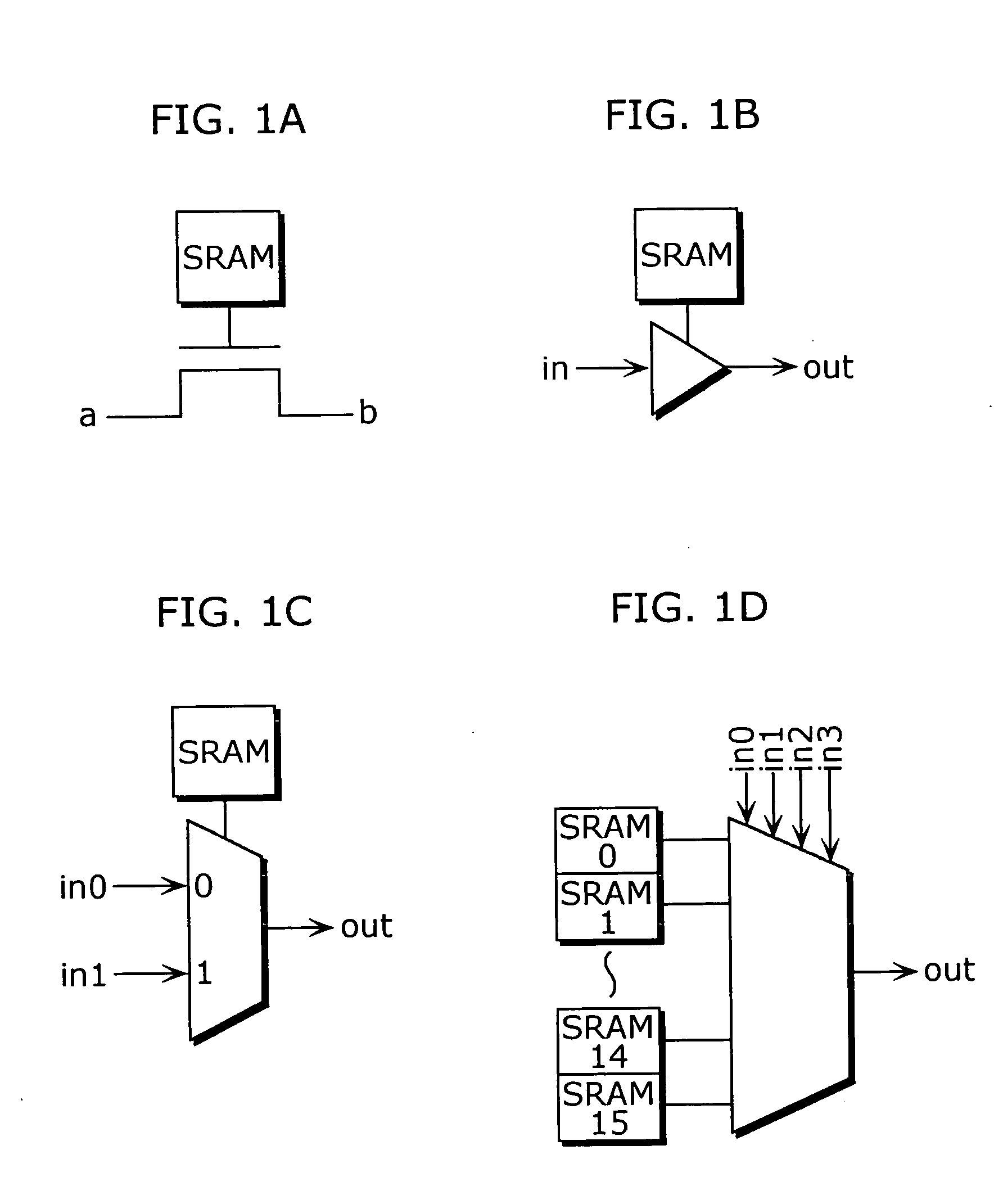Semiconductor device
- Summary
- Abstract
- Description
- Claims
- Application Information
AI Technical Summary
Benefits of technology
Problems solved by technology
Method used
Image
Examples
first embodiment
[0109] Here, a reconfigurable logic circuit in the first embodiment of the present invention is explained. FIGS. 6A to 6D are diagrams showing circuit elements used in a reconfigurable logic circuit.
[0110]FIG. 6A shows a circuit element which functions as a pass transistor. The pass transistor has nonvolatile memory cells NVC (a) and NVC (b), a switch circuit SW, a SRAM and a transistor. The NVC (a) is a nonvolatile memory cell which uses ferroelectric capacitor as a memory cell, and holds data which is a part of circuit configuration information. The NVC (b) is a similar memory cell and holds data that is a part of other circuit configuration information. The switch circuit SW selects one of the nonvolatile memory cells NVC (a) and NVC (b) in accordance with a reconfiguration control signal RC, and connects the selected nonvolatile memory cell to the SRAM only when the configuration is performed. The SRAM is a latch circuit which reads data from and writes data to the nonvolatile ...
second embodiment
[0143] It is explained about a ferroelectric incorporated latch circuit according to the second embodiment of the present invention. FIG. 19 shows a circuit diagram of the second embodiment. In the latch circuit, two inverters INV0 and INV1 are connected in cross-couple, and data is written and read from bit lines BL and XBL by access transistors Q0 and XQ0 whose gates are controlled by the world line WL. Also, two data storage ferroelectric capacitors CF0 and XCF0 and two load ferroelectric capacitors CF1 and XCF1 are respectively connected to the two storage nodes N0 and XN0 in the latch circuit via the transistors Q1, XQ1, Q2 and XQ2 whose gates are controlled by the control lines EN0 and EN1. Theses connection nodes are available for grounding by the transistors Q3, XQ3, Q4 and XQ4 whose gates are controlled by the control lines EQ0 and EQ1. One side of electrodes of the CF0 and XCF0 is respectively connected to the plate line PL0 and one side of electrodes of the CF1 and XCF1 i...
third embodiment
[0153]FIG. 25 shows a ferroelectric built-in latch circuit diagram according to a third embodiment of the present invention. In the present embodiment, there are two memory cells composed of a latch circuit and data storage ferroelectric capacitors and a load cell including load ferroelectric capacitors is shared. In FIG. 25, an element to which a number (0) is attached forms a first memory cell and an element to which a number (1) is attached forms a second memory cell. The latch circuit is formed by connecting two inverters INV0 (0, 1) and INV1 (0, 1) in cross couple. In the latch circuit, data is written in and read from the bit lines BL and XBL by the access transistors Q0 (0, 1) and XQ0 (0, 1) whose gates are controlled by the word line WL (0, 1). Two data storage ferroelectric capacitors CF0 (0, 1) and XCF0 (0, 1) are respectively connected to the two storage nodes N0 (0, 1) and XN0 (0, 1) of the latch circuit via the transistors Q1 (0, 1) and XQ1 (0, 1) whose gates are contro...
PUM
 Login to View More
Login to View More Abstract
Description
Claims
Application Information
 Login to View More
Login to View More - R&D
- Intellectual Property
- Life Sciences
- Materials
- Tech Scout
- Unparalleled Data Quality
- Higher Quality Content
- 60% Fewer Hallucinations
Browse by: Latest US Patents, China's latest patents, Technical Efficacy Thesaurus, Application Domain, Technology Topic, Popular Technical Reports.
© 2025 PatSnap. All rights reserved.Legal|Privacy policy|Modern Slavery Act Transparency Statement|Sitemap|About US| Contact US: help@patsnap.com



